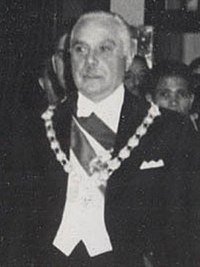Rafael Leonidas Trujillo Molina
|
Generalissimo Rafael Trujillo |
|
|---|---|

Trujillo in 1952
|
|
| 36th & 39th President of the Dominican Republic | |
|
In office 16 August 1930 – 16 August 1938 |
|
| Vice President |
Rafael Estrella Ureña (1930–1931) vacant (1932–1934) Jacinto Peynado (1934–1938) |
| Preceded by | Rafael Estrella Ureña (acting) |
| Succeeded by | Jacinto Peynado |
|
In office 18 May 1942 – 16 August 1952 |
|
| Vice President | None |
| Preceded by | Manuel de Jesús Troncoso de la Concha |
| Succeeded by | Héctor Trujillo |
| Personal details | |
| Born |
Rafael Leónidas Trujillo Molina 24 October 1891 San Cristóbal, Dominican Republic |
| Died | 30 May 1961 (aged 69) Ciudad Trujillo, Dominican Republic |
| Nationality | Dominican |
| Political party | Dominican |
| Spouse(s) | Maria Martínez de Trujillo |
| Children |
Ramfis Trujillo Martínez (b. 1929) Odette Trujillo Ricardo (b. 1936) María de los Ángeles del Sagrado Corazón de Jesús Trujillo Martínez (b. 1939) Yolanda Trujillo Lovatón (b. 1939) Leonidas Radhamés Trujillo Martínez (b. 1942) Rafael Trujillo Lovatón (b. 1943) |
| Residence | Santo Domingo |
| Profession | Soldier, Businessman, Statesman |
Rafael Leónidas Trujillo Molina (Spanish pronunciation: [rafaˈel leˈoniðas tɾuˈxiʝo]; 24 October 1891 – 30 May 1961), nicknamed El Jefe (Spanish: [el ˈxefe], The Chief or The Boss), was a Dominican politician and soldier, who ruled the Dominican Republic from February 1930 until his assassination in May 1961. He served as president from 1930 to 1938 and again from 1942 to 1952, ruling for the rest of the time as an unelected military strongman under figurehead presidents. His 31 years in power, to Dominicans known as the Trujillo Era (Spanish: El Trujillato), are considered one of the bloodiest eras ever in the Americas, as well as a time of a personality cult, when monuments to Trujillo were in abundance. Trujillo and his regime were responsible for the death of more than 50,000 people, including between 20,000 to 30,000 in the infamous Parsley massacre.
The Trujillo era unfolded in a Caribbean environment that was particularly fertile for dictatorial regimes. In the countries of the Caribbean basin alone, his dictatorship was concurrent, in whole or in part, with those in Cuba, Nicaragua, Guatemala, El Salvador, Honduras, Venezuela, Colombia, and Haiti. In retrospect, the Trujillo dictatorship has been characterized as more exposed, more achieved, and more brutal than those that rose and fell around it.
Trujillo's rule brought the country a great deal of stability and prosperity throughout his 31-year reign. The price, however, was high—civil liberties were non-existent and human rights violations were routine. Due to the longevity of Trujillo's rule, a detached evaluation of his legacy is difficult. Supporters of Trujillo claim that he reorganized both the state and the economy, and left vast infrastructure to the country. His detractors point to the brutality of his rule, and also claim that much of the country's wealth wound up in the hands of his family or close associates.
Rafael Leonidas Trujillo Molina was born in San Cristóbal, Dominican Republic into a lower-middle-class family, to José "Pepito" Trujillo Valdez, whose father was a Spanish sergeant, and Altagracia Julia Molina Chevalier, later known as Mamá Julia, whose mother was of Franco-Haitian and Mulatto Haitian origin. He was the third of eleven children; he also had an adopted brother, Luis Rafael "Nene" Trujillo (21 January 1935 – 14 August 2005), who was raised in the home of Trujillo Molina.
...
Wikipedia
